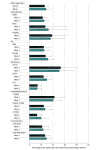Psychological Distress and COVID-19-Related Stressors Reported in a Longitudinal Cohort of US Adults in April and July 2020
- PMID: 33226420
- PMCID: PMC7684524
- DOI: 10.1001/jama.2020.21231
Psychological Distress and COVID-19-Related Stressors Reported in a Longitudinal Cohort of US Adults in April and July 2020
Abstract
This study uses national survey data to compare self-reported psychological distress among US adults in April and July 2020 by demographic and stressor type subgroups.
Conflict of interest statement
Figures


References
-
- NORC at the University of Chicago Technical overview of the AmeriSpeak panel NORC's probability-based household panel. Updated June 18, 2020. Accessed October 7, 2020. https://amerispeak.norc.org/Documents/Research/AmeriSpeak%20Technical%20...
Publication types
MeSH terms
Grants and funding
LinkOut - more resources
Full Text Sources
Medical
Miscellaneous

